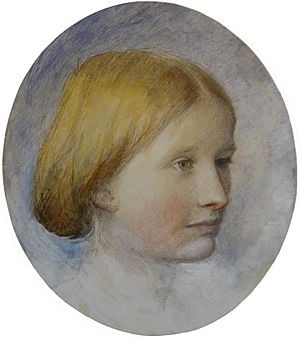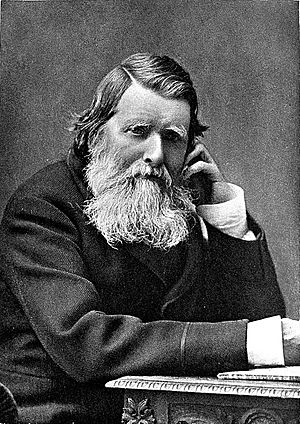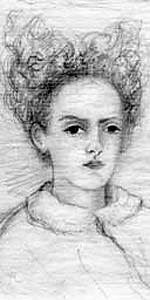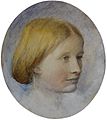Rose La Touche facts for kids
Rose La Touche (1848–1875) was a student of the famous English art historian John Ruskin. She was an important person in his life and inspired his well-known book, Sesame and Lilies (1865).
Contents
Early Life
Rose La Touche was born in 1848. Her parents were John La Touche and Maria La Touche. Her family was from Ireland and lived in a place called Harristown House in County Kildare.
Meeting John Ruskin
John Ruskin first met Rose on January 3, 1858. At the time, Rose was 10 years old, and Ruskin was almost 39. He became her private art teacher. They kept up their lessons and friendship through letters until Rose was 18.
Rose's mother, Maria La Touche, had asked Ruskin for help with her children's education. She had heard about him from her friend, Louisa, Lady Waterford. Ruskin later wrote about this in his autobiography, Praeterita:
A lady wrote to me, saying she believed I was the best art teacher. She wanted her children, especially her younger daughter, to learn art correctly.
When Ruskin first visited the La Touche family, he was very impressed by them. He felt there was something special about Rose. He described meeting her for the first time:
The drawing room door opened, and Rosie came in. She looked at me with her blue eyes. She gave me her hand, like a friendly dog. She was nine years old, almost ten. Her eyes were deep blue, and her lips were lovely. Her hair was soft and curled around her forehead.
Rose's Childhood Personality
Rose was a lively and smart young girl, but she also kept her childlike qualities. Tim Hilton, a writer, described her as a bit of a puzzle. She sometimes understood adult ideas, but then she would act like a child again. She could be charming and even a little playful, but also serious. Ruskin once said, "I don't know what to make of her... She wears her round hat in the sauciest way possible—and is a firm—fiery little thing."
Ruskin was very interested in Rose, and they wrote many letters to each other. Rose's first letter to Ruskin impressed him so much that he included it in his book Praeterita. He wrote that he wanted to share her letter with others.
In her letter, Rose called Ruskin "Dearest St. Crumpet," which was her special nickname for him. She wrote kind and thoughtful notes about how much she and her family thought about him during their travels. She wrote:
I wish so much that you were happy. God can make you so. We will try not to forget all you taught us. It was so nice of you. Thank you so much from both of us. Mama is very glad you went to Dr. Ferguson. She says you must not give him up. How very kind of you to see and talk to our old man. Certainly the name is not beautiful. We have all read your letter and we all care for it. That was indeed a "dear Irish labourer." Will you give them our love please and take for yourself as much as ever you please. It will be a great deal if you deign to take all we send you. I like Nice, but I don't much like being moved except going home. I am ever your rose.
Relationship with Ruskin
Many people wonder when Ruskin developed strong feelings for Rose. Most experts believe it was when she was between 14 and 18 years old.
Rose's parents asked the author George MacDonald to look after Rose while they were away. He also helped Ruskin and Rose communicate, acting as a close friend and advisor.
Rose's parents did not allow Ruskin to marry their daughter. This was partly because Ruskin's first wife, Effie Gray, had warned them about him. Ruskin's marriage to Effie had ended after six years.
Ruskin asked Rose to marry him again later, after she was old enough to make her own choices. However, she still said no. She was willing to marry if the marriage would not be a typical one, similar to Ruskin's first marriage. Her doctors had told her she was not well enough for a regular marriage. But Ruskin did not want another marriage like that because he was worried about his reputation.
Rose's Passing
Rose La Touche passed away on May 25, 1875, at the age of 27. She was in a nursing home in Dublin at the time. The exact cause of her death is not fully clear. Some suggest it was due to mental health struggles, or a combination of factors.
Her death was very sad and is often thought to have caused Ruskin to have periods of mental illness starting around 1877. He became convinced that the Renaissance painter Vittore Carpaccio had included pictures of Rose in his paintings about the life of Saint Ursula. Ruskin also found comfort in Spiritualism, trying to connect with Rose's spirit.
Rose and Ruskin's connection is mentioned in his book on education and culture, Sesame and Lilies. Many parts of this book have hidden meanings and direct references to the La Touche family.
Images for kids







